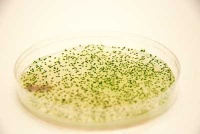The new method has two advantages for the long-term, global-scale goal of achieving a cleaner and greener energy economy, the researchers say. First, it recycles carbon dioxide, reducing greenhouse gas emissions resulting from the burning of fossil fuels. Second, it uses solar energy to convert the carbon dioxide into a liquid fuel that can be used in most cars.
While other alternatives to petrol include deriving biofuels from plants or from algae, both of these processes require several intermediate steps before refinement into usable fuels.
‘This new approach avoids the need for biomass deconstruction, either in the case of cellulosic biomass or algal biomass, which is a major economic barrier for biofuel production,’ said James C Liao, professor of chemical and biomolecular engineering at UCLA and associate director of the UCLA-Department of Energy Institute for Genomics and Proteomics. ‘Therefore, this is potentially much more efficient and less expensive than the current approach.’
Using the cyanobacterium Synechococcus elongatus, researchers first genetically increased the quantity of the carbon dioxide-fixing enzyme RuBisCO. They then spliced genes from other microorganisms to engineer a strain that intakes carbon dioxide and sunlight and produces isobutyraldehyde gas. The low boiling point and high vapour pressure of the gas allows it to easily be stripped from the system.
The engineered bacteria can produce isobutanol directly, but researchers say it is currently easier to use an existing and relatively inexpensive chemical catalysis process to convert isobutyraldehyde gas to isobutanol, as well as other useful petroleum-based products.
An ideal place for this system would be next to existing power plants that emit carbon dioxide, the researchers say, potentially allowing the greenhouse gas to be captured and directly recycled into liquid fuel.
‘We are continuing to improve the rate and yield of the production,’ said Liao. ‘Other obstacles include the efficiency of light distribution and reduction of bioreactor cost. We are working on solutions to these problems.’
The research was supported in part by a grant from the US Department of Energy.

Genetically engineered strains of the cyanobacterium Synechococcus elongatus in a Petri dish





Nanogenerator consumes CO2 to generate electricity
Whoopee, they've solved how to keep a light on but not a lot else.